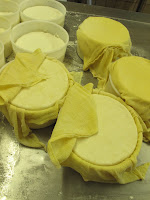We make two types of cheese at the farm:
Two types of cheese from Renee Orenstein on Vimeo.
Steps to make fresh cheese:
1. The milk is transported down to the fromagerie (the cheese building) and distributed into plastic bins with ferment powder and rennet.
What goes into the milk from Renee Orenstein on Vimeo.
Transferring the milk to the fromagerie from Renee Orenstein on Vimeo.
2. The milk has to sit for about a day so it has time to ferment and become cheese. The consistency becomes similar to fresh yogurt.
(fresh cheese with pesto and olive before flipping)
5. The next step is salting the cheese. Sprinkling some salt on top soaks up even more of the water.
6. The next day, we take the cheese out of the molds and place them on drying racks. Et voila! Fresh cheese.
Steps to make tome cheese: (sorry no videos for this one...)
1. The milk is transferred to the tome, a large metal basin (shown in video above), and is heated with a gas flame while stirring occasionally.
2. After reaching 39 degree Celsius, we scoop the cheese into a strainer and transfer it to a plastic mold lined with a cheese cloth. One day's worth of milk makes 6 molds of this cheese. It isn't as economical as making the fresh cheese, but some people prefer the taste and texture.
3. We then press the cheese into the mold using our hands to get the air bubbles out, cover it with a corner of the cheese cloth, and stack it on top of the other tome cheeses.
4. A few hours later, the cheese is flipped and placed back in the mold upside down, still in the cloth.








I ant to eat cheese!!! looks sooo good!
ReplyDeleteSo how is your digestive system handling all this cheese?!?!?!
ReplyDelete